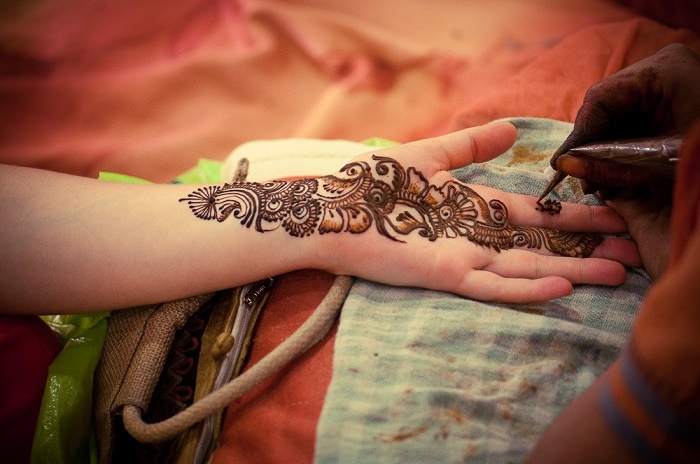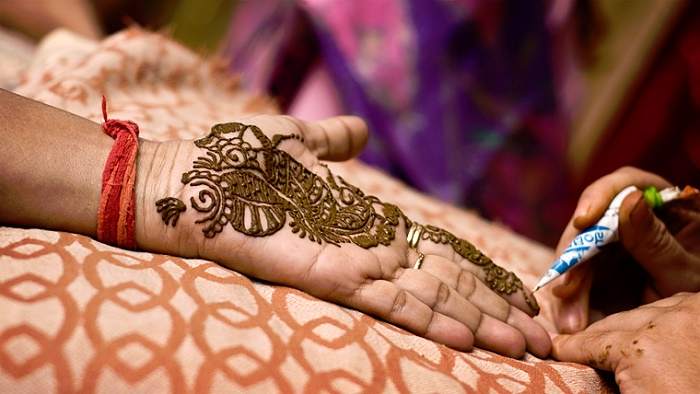
Image Credit: YouTube
Mehndi is yet another traditional yet exciting pre wedding ceremony. In Indian weddings, a lot of emphasis is given on customs and rituals and the same is reflected in the Mehndi ceremony before marriage. Mehendi ceremony has become such an integral part of the wedding ceremony that it cannot be imagined without it. Furthermore, Mehndi is one of the sixteen adornments of the bride and her beauty is incomplete without it. Mehndi ceremony usually takes place just before marriage. According to the ritual, the bride does not step out of the house after this ceremony. Mehndi ceremony is essentially organized by the family of the bride and is usually a private affair which takes place in the presence of friends, relatives and family members. However, the scale of the ceremony depends upon individual choice. Some people celebrate it with great pomp and show.
Historical Background
Mehndi is one of the oldest forms of body art conceived by man. The Hindi and Arabic word Mehendi is derived from a Sanskrit word ‘mendhika’ which referred to the henna plant itself. Reference to uses of henna can be traced back to the Bronze ages. In the bible, henna is referred to a Camphire. In and around the Indian subcontinent, henna has been used as a cosmetic even before Vedic ages. India is considered as the source from where the body art traditions with henna spread to different parts of the world like Egypt, Asia Minor and the Middle East. References of henna during the mummification process of Pharaohs as well as anecdotes of the famous queen Cleopatra using henna to paint her body are well-known in history. Prophet Muhammad is known to use henna paste to color his graying beard and was known to advocate use of henna to others as well. Use of henna is considered immensely auspicious in many traditions around the world, especially within Hindus, who would consider Mehndi part of the customary 16 adornments or Solah Shringaar.

Henna
Henna (Botanical name: Lawsonia inermis) is a small shrub-like plant, found in tropical climates of Indian sub-continent, Malaysia, Africa, Middle Eastern countries. The leaves and branches produce a red-orange dye known as Lawsone that is responsible for imparting the characteristic color when bound with protein molecules of the upper skin layer. The plant is commercially cultivated in Rajasthan, Punjab, Gujarat and parts of Madhya Pradesh.
Preparation of Henna Paste
Traditionally, the Mehndi paste is made from dried powdered henna leaves. The leaves are dried in sun, ground and sieved to obtain a fine mossy green powder, which is then combined with water, lemon juice, drops of eucalyptus oil, and mixed till a smooth paste is obtained. The paste is soaked overnight for maximum infusion and then poured inside a plastic cone. Smaller cones are preferred as it affords easier application.
Application
The tips of the cones are cut according to the preferred thickness of the lines needed. The cones are squeezed lightly to ensure smooth, continuous flow of Mehndi. Application is generally started from forearms, gradually moving down the hand, ending in the fingertips.

Image Credit: momentaryawe.com/blog/wp-content/uploads/2009/12/mehndi.jpg
Design Trends
Gone are the days when certain aunties and sisters were in demand around the neighborhood for their expertise in Mehndi designs. Now Mehndi ceremony centers around professional Mehendi artist who specializes in the latest trends in henna art. Traditional Indian designs include peacock motifs, floral designs, bride/groom replicas and other elements that cover every inch of the hand, forearms, feet and calves. The fingertips are generally covered in thick layers of henna paste. The idea is to adorn the bride’s body in imitation of expensive Jewelry. For those who are minimalists, they can choose Arabic designs where the Mehndi motifs are generally applied to one side of the hand and feet and do not extend to forearms or calves. Floral and paisley motifs dominate this style and the designs are generally curvy with lots of emphasis on vines. Indo-Arabic style of Mehndi fuses these two design trends into a classy, artistic genre. Latest trends in bridal henna designs is incorporation of colors in between henna motifs, addition of stones and blings, inclusion of glitters or metallic dusts. Geometric patterns and white henna designs are also in vogue today.

Aftercare
The henna needs to be kept on for a minimum of 4 hours for deep and uniform color. The longer the paste is kept, the deeper will be the color. The color actually intensifies depending on one’s body heat, so the henna-painted body parts can be wrapped in plastic wraps or foils to seal in the body heat. A mixture of lemon juice and sugar should be applied on the designs with a brush or light cloth at 1 hour intervals so that the dried Mehndi does not fall off and stays put ensuring better color. Another way to ensure better color development is to dry roast some cloves on a tawa and letting the hands soak up the smoke. The Mehendi should never be removed by water after it has dried and should be done by simply rubbing the hands together as the dried bits come off easily.
The Ritual
The Mehendi Ceremony generally takes place the day before the wedding, in the morning. The bride and the groom’s family observe this ritual separately at their own residences. It is traditionally a women centric ceremony with the men of the family generally not participating. The outfits preferred for the ceremony are simple, in light colors, nothing too flashy. The venues are decked up with flowers and colorful draperies. The bride wears a light yellow or light green colored Lehenga or Salwar Kameez with short sleeves preferably and the groom wears Kurta Pajama also in light colors. It is not compulsory for the groom to wear Mehendi, but a little bit is applied on his hands and feet in simple dots or small designs. The ceremony also involves application of oil on the groom’s hair. The henna for the bride’s ceremony has to arrive from the groom’s side along with some other gifts like fruits, dry fruits and sweets. Women of the house assemble and the Mehndi is either applied by one of the bride’s relative or nowadays by professional Mehendi artists. Designs are more elaborate and depending on what the bride prefers, the henna is applied on the front and back of her palm, forearm, till above the elbows, and on the feet till below the knee. Elderly ladies sing traditional Mehendi songs with dholaks and other musical instruments. Women relatives of the bride also get Mehendi applied to their hands, although the designs are not as elaborate as the bridal Mehendi.
Popular Beliefs
The Mehendi ceremony contains within itself a host of traditional beliefs that are handed down the generations. Traditionally, somewhere within the intricate bridal Mehendi, the groom’s initial is included. In post marriage ceremonies, the groom has to look and find it out. This facilitates a nice ice-breaker for the newly wedded couple especially in case of an arranged marriage. It is also said that the darker the color of the Mehendi, the more love the bride will receive at her in-laws and especially from her husband. The longevity of the color of Mehendi has special significance as well. In older days when arranged marriages were predominant, the bride retaining her Mehendi while visiting her parents’ house after the wedding signaled her mother that the in-laws were considerate and caring.
Significance
Use of Mehendi in a pre-wedding ritual is not just cosmetic but has deep underlying scientific reasons behind it. Henna is known for its cooling properties and is supposed to calm the bride’s nerves when applied to her hands and feet.
Indian weddings comprise of a host of pre and post wedding rituals that extend the happy occasion through days before and after the actual wedding day. These colorful events bring the whole family together, even from far off places. The immediate and extended families, friends and neighbors get together to celebrate the union through various time-tested rituals throughout a span of several days. The Mehendi Ceremony is one such event that is an indispensible part of the wedding celebrations. Mehendi Ceremony generally refers to application of a henna paste in elaborate intricate designs on the bride’s hands and feet. An immensely colorful event, with lots of singing and dance performances involved, the Mehendi ceremony officially kicks off the wedding festivities in full gear.
This ritual is not only part of Hindu weddings in Northern and Eastern India but also a part of the wedding rituals among Indian Muslims. The ceremony is observed in countries adjoining India like Pakistan and Nepal, as well as in several Arab countries in the Middle East.
Although, the ritual was predominantly observed in parts of northern India, Rajasthan, Gujarat, Uttar Pradesh, Bihar, Madhya Pradesh and Punjab, the trend has gained popularity all over India. More and more cultures are embracing the idea of Mehendi Ceremony as a pre-wedding ritual mainly due to the aesthetics involved. The ceremony has become a symbol of grandeur, fun and festivities, and excuse for some major pre-wedding girl bonding.




